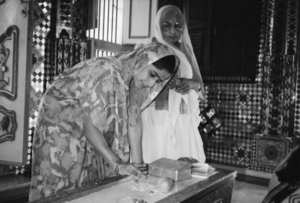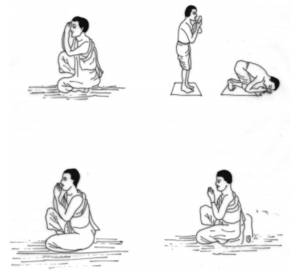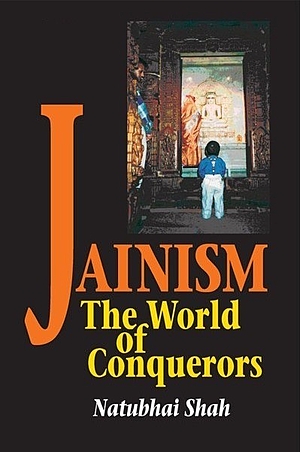The majority of Jains are Svetambar Murtipujakas; among them the rituals vary due to historical and regional circumstances, but they follow a general pattern similar to that described in the last chapter. Some Svetambar rituals are very elaborate and colourful and it is believed that they were developed to counter the attraction of the rituals of the Hindu 'devotional movement' (bhakti marga). This chapter describes worship in the temples and other public arenas.
The daily life of a pious Svetambar is interwoven with the ritual acts of the six essential duties. Every Jain learns the Navakara Mantra from childhood. The Navakara Mantra is a formula of veneration, meditation on the virtues and surrender, not a petition, to the five 'supreme beings' (panca parmesthis). The rolling sounds of the ancient Prakrit language used in this mantra echo at every Jain religious gathering, chanted in unison by the congregation. The meditative, silent recitation of this mantra may be performed at any time, in any place and by anyone. The mantra, transliterated into English, is as follows:
| Namo arihantaanam | I venerate the enlightened souls |
| Namo siddhaanam | I venerate the liberated souls |
| Namo ayariyaanam | I venerate the spiritual leaders |
| Namo uvajjhayaanam | I venerate the spiritual preceptors |
| Namo loe savva sahuna | I venerate all ascetics in the world |
| Eso panca namokkaro | These fivefold venerations |
| Savva paavapanaasa | Destroy all sins |
| Mangalanam ca savvesim | Of all auspicious things |
| Padhamam havai mangalam | It is the most auspicious. |
Veneration of the Jina (deva pujaa)
Svetambar murtipujakas believe that image worship is necessary for spiritual progress, which is a gradual process. If one reckons one's age from the time when one gains spiritual understanding, rather than from birth, then most of the laypeople are like children in spiritual terms. They have hardly begun their journey towards spiritual enlightenment. As pictures, figures and drawings are used to help children to acquire an understanding of concepts, in the same way, laypeople and ascetics alike require the help of images in the early stages of their spiritual 'journey'. The consecrated images used are of tirthankaras and they serve as a focus for devotion, and the lives of the tirthankaras represented by the images are the example which the worshipper seeks, through prayer, meditation and conduct, to emulate. Jain seers teach that worship focused upon images is necessary for the first seven of the fourteen stages of spiritual development. From the eighth stage onwards one's spirituality becomes sufficiently developed so that one can meditate on one's soul without any external aid.
Deva pujaa involves worship of images by: the recitation of the names of tirthankaras; the singing of hymns; listening to the recitation and the hymns; respectfully bowing to images; meditation; 'surrender', that is, adopting a spirit of detachment from worldly affairs; and making offerings to the images.
In preparation for pujaa, worshippers bathe themselves, put on clean clothes, 'purify' their minds by cultivating feelings of detachment, and select 'fitting' items for the worship of the images. If making monetary offerings or temple donations, they should take care that the money was honestly made. In the temple rituals, worshippers should observe the accepted customs, ceremonies or the rites for the worship, which are intended to create peace of mind, develop a sense of detachment, and aid in spiritual progress.
Devout Jains perform deva pujaa daily. If unable to perform all the rituals of the pujaa for any reason, they should at least try to go to the temple and pay reverence to the jina each day. The devout will refrain from eating anything before going to the temple in the morning, in fact, will not even brush their teeth. They will not eat lunch before noon worship, and will not retire to bed before making their evening visit to the temple. Svetambars erform rituals for devotion, for purification, as an austerity or as a ceremony.
Devotional Rituals
The devotional rituals at the temple may be the 'veneration of temples and jinas' (caitya vandan), the 'eightfold worship' (asta-prakaari pujaa), or the sacred lamp-waving ritual (aarati).
The full ritual of the deva pujaa is performed in three stages: worship by 'contact with an image' (anga pujaa); 'worship before an image' (agra pujaa); and the 'psychic' worship (bhaava pujaa). Bathing and the wearing of clean clothes are obligatory for worshippers before they perform anga pujaa. Male worshippers wear two unstitched garments, female worshippers wear three stitched garments. For the agra and bhaava pujaa bathing beforehand is not required. Normal clean clothing may be worn. If time is short, some worshippers perform only the 'worship before an image' and 'psychic' worship, or a shortened version of the prayers.
The following account explains the basic sequence of the ritual. Whilst it remains the same in general outline, there can be considerable variation in practice. As this is usually a personal ritual, worshippers may give it their own particular order and character. There is a fairly wide choice of prayers and invocations. The worshipper enters the temple pronouncing 'nissahi', indicating that the worshipper has put aside all thought of outside activities on entering the temple. It is repeated when the worshipper leaves the main body of the temple to enter the inner shrine (garbha griha) where the principal images are situated, indicating that worshippers have ceased all thought of the mundane activities associated with the temple. It is said a third time at the conclusion of the astaprakaari pujaa, when the worshipper performs the bhaava pujaa (caitya vandana).
On entering the temple, worshippers first stand before the main tirthankara image and with folded hands, recite the Navakara Mantra or say 'namo jinanam', ('I venerate the Jinas'), or recite hymns and then walk three times around the shrine. The circumambulation is clockwise so that the image is kept on the worshipper's right-hand side. During this a suitable invocation is recited. The three circuits around the image relate to the three Jewels - Right Faith, Right Knowledge and Right Conduct. Once more facing the image, a short verse of prayer is uttered. Then worshippers mark their foreheads with a 'dot' (tilak) of sandalwood paste, which is kept outside the main temple. The tilak signifies obedience to the teachings of the jina.
Anga Pujaa: Worshippers then tie on a 'mouth-kerchief' (mukhakosa) or use the end of the cloth worn on the upper part of the body, to cover the mouth. This is to prevent harm to tiny living beings in the air. Then, pronouncing 'nissahi', the worshipper goes into the shrine and cleans away the previous day's flowers and sandalwood paste from the image using a soft brush, usually made of peacock feathers, and a moistened cloth.
Then follows the 'sacred water' or 'anointing' worship. A mixture of the 'five nectars' (pancaamrita), consisting of water, milk, curds, ghee and sugar, is poured over the image from a spouted vessel. The image is then washed with clean water. This anointing recalls the bathing of the newborn tirthankara with milky water by the celestial king Indra, on Mount Meru, and a recitation relating to this is spoken. The image is then wiped dry with three cloths, to ensure that all moisture is removed. The symbolic washing of the image is believed to have a parallel effect upon the worshippers, dissolving karmic accretions attached to their souls. In most temples cleaning and washing of the images is carried out by pujaaris. After the washing, the water containing the five nectars is collected in a bowl; this bathing liquid (nhaavana) is considered sacred by the laity and it is customary for them to apply it to their foreheads and eyebrows, and sprinkle to various locations as purificatory liquid. It is believed by devotees that nhaavana helps to cure physical ailments. In one of his sermons in1984 at Pali (Rajasthan) Aacaarya Padmasagar has given scientific reasons for the auspicious and curative properties of nhaavana, due to the fact that, it contains electronic waves of devotional thoughts of the worshippers who have bathed the images holding the jug of pancamrat with both hands, the electronic thoughts being passed via their fingertips.
The next stage of the ritual is worship with sandalwood paste (candan pujaa). This involves anointing the image with sandalwood paste on the big toes, knees, wrists, shoulders, crown of the head, forehead, neck, chest and the navel. Appropriate verses accompany each of these actions. Flowers are placed before the jina image, usually at the feet, although occasionally the image is garlanded.
In the rituals of the candana pujaa, each anointing of a different part of the image is a 'physical' prayer for a particular desired outcome. The toes of the image are anointed out of respect for the jina and as a prayer in humility, for detachment and jina-like contentment. It also expresses the desire for the welfare of all beings.
Anointing the knees is for the strength to meditate, to achieve self-realisation. Anointing the wrists is linked to the charitable giving of the physical possessions and the passing of spiritual knowledge to others. Anointing the shoulder is to develop humility. Anointing the crown of the head shows veneration for the liberated soul of the jina. Anointing the forehead shows respect and submission to the teachings of jina. Anointing the neck expresses the desire always to speak in such a way as to promote the spiritual welfare of oneself and others.
The chest is anointed from the desire to have the jina-like virtues of detachment, control over the passions, friendship, compassion and equanimity. Anointing the navel expresses the desire to experience the attributes of purified souls. Using flowers in worship is symbolic of the fragrance created by virtuous nature and good deeds. (Hemratnavijay 1990: pp.109-116)
Agra Pujaa: This ritual is performed outside the inner shrine of the temple, where the worshipper offers waving burning incense, and then waves a ghee lamp before the image. Incense is used in worship, for a prayer for destroying karma and the passions, in a similar way to the smoke of burning incense. The 'lamp-waving' worship symbolises the removal of ignorance and the achievement of complete understanding.
Following the offering of incense and light, further offerings of rice, a sweet, and a fruit are performed. This completes the asta-prakaari-pujaa. To make these offerings, the worshipper sits at a low table and on it arranges grains of rice in the form of the traditional symbols of the Jain faith. First there is a swastika; the four arms symbolising the four states of embodiment (human, celestial, animal and plants, or infernal) in which a soul may be reborn. Above this, three dots are placed symbolising Right Faith, Right Knowledge and Right Conduct. At the top of this rice 'diagram', a crescent symbolizes the abode of the liberated souls and a 'dot' above the crescent symbolises the liberated souls. The sweet is placed on the swastika and the fruit on the crescent. The rice grains symbolise freedom from rebirth; polished rice grains will not germinate. The sweet symbolises the wish to achieve a state in which one does not desire food. The fruit symbolises the desired outcome of the worship, liberation.
Jains are not permitted to make use of anything offered to an image. Fruits, sweets, nuts, rice or other ingredients offered by worshippers may be utilised by the temple staff, if they are non-Jains. During worship some devotees wave a 'brush fan' (caamar) signifying their devotion, and gaze at the image of the tirthankara, reflected in a mirror; the symbolism of the reflected image signifies the purity of the soul.
Plate 5.5 A devotee making swastika with rice grains in a temple at Boradi, Gujarat.

Bhaava Pujaa: 'Psychic' worship (bhaava pujaa) consists of a series of rituals, for temple veneration, which is called caitya vandana. In this worship hymns of praise, adoration and devotion are recited together with the performance of penance and meditation. Caitya vandana helps the devotee to develop spirituality and shed karma attached to the soul. Hence this worship should be undertaken with full concentration and understanding of the meaning of each ritual.
There are a number of prayers and rituals in the caitya vandana. Veneration of the jina. Asking for forgiveness for harming any living being, knowingly or unknowingly, while coming to or going from the temple. Expression of a desire to shed karma acquired during those journeys. Performance of penance with bodily detachment and meditation in the form of a sutra on the adoration of and devotion to the twenty-four jinas, or the four silent recitations of the navakara mantra. Prayer of adoration and devotion to the twenty-four jinas of this time-cycle, and of the past and future. Prayer to Shantinatha, the sixteenth tirthankara, bestower of welfare to all, and a guide on the spiritual path towards salvation. A sutra of veneration to all the jina images throughout the universe. A sutra offering respect and veneration to all the jina temples throughout the universe. A sutra of veneration to the five 'supreme beings' (parmesthis). A sutra of veneration to all the saints throughout universe. Recitation of hymns of praise, attributes and adoration of the tirthankaras. A sutra containing prayers to the jinas, whose teachings are the most auspicious, for aid in shedding karma and worldly miseries; A sutra of penance for allowing one's mind to be distracted during the rituals; The mental recitation of navkar mantra in a standing posture with bodily detachment. The ritual concludes with a prayer and adoration of the tirthankaras. After this worship, the devotee rings the bell that is hung just outside the shrine as a sign of rejoicing. On many occasions the jina images are decorated with silver or gold foil, or with other rich decorative materials, to recall the tirthankaras' previous lives as monarchs.
Normally, upon first seeing the image of the jina, the worshipper will engage in a contemplation of the different stages through which the jina passed in life, such as birth, reign as a monarch, renunciation, omniscience and liberation.
Aarati: This popular waving lamp ritual involves the rotating of five gee lamps. It is performed in mid-morning and is the last ritual at night. The five lamps symbolise five forms of knowledge: sensory, scriptural, clairvoyant, 'telepathic' and omniscient. It is a mass ritual, accompanied by melodic singing and music. Aarati is performed as a symbol of veneration to the jinas and is believed to help to prevent malevolent thoughts.
Mangala Divo: This ritual of rotating a single lamp follows aarati. Mangala divo symbolises everlasting knowledge passed on by the jina. This mass ritual includes a prayer for the welfare of all living beings. It is believed that Aacaarya Hemcandra initiated this ritual in the days of King Kumarpala in the twelfth century CE, adopting the Hindu tradition of sharing the lamp-waving ritual with others (Hemratnavijay 1990: pp.64-94).
Plate 5.6 Devotees performing the ritual of caitya vandan at Boradi, Gujarat, India.

Figure 5.5 Some of the postures adopted during the ritual of caitya vandan.

Nava smarana: Some staunch devotees recite daily the nine eulogies in veneration of the tirthankaras, panca parmesthis, the goddesses of learning and the guardian deities. They are the Navakara Mantra, Uvasaggaharam Stotra, Santikarana Stotra, Tijyapahutta Stotra, Nami Una Stotra, Ajita Santi, Bhaktaamara Stotra, Kalyaana Mandir Stotra, and Bruhacchantih Stotra. A further description of the Uvasaggaharam, Santikarana, Ajita Santi and Bruhacchantih is given later in this chapter. The Tijya pahutta is a prayer to the 170 tirthankaras of the universe and the 16 goddesses of learning for the destruction of the devotee's karma, and the avoidance of calamities that may be caused by the planets, by ghosts or evil celestial beings. The Nami Una Stotra is a eulogy in praise of Parsvanatha and it is believed that devotees who recite this mantra will avoid calamity and dispel fear. The Bhaktaamara Stotra is a forty-four-verse eulogy in praise of Risabhdeva, composed by Mantunga Suri. The background behind the composition of this eulogy is interesting (see chapter 2.4). The Kalyaana Mandir Stotra is a eulogy in praise of Parsvanatha composed by Aacaarya Siddhasen Divakar Suri.
Celebratory Rituals
Svetambars celebrate a number of Jain sacred days by performing the special pujaas such as the snaatra pujaa, panca kalyanaka pujaa, santi snaatra pujaa, antaraaya karma pujaa, siddha cakra pujan, arihanta mahapujan, atthai mahotsava, adhaara abhiseka and anjana salaakaa are performed on celebratory occasions. They are very colourful and vibrant ceremonies, which clearly show the popularity of Jainism as a living tradition. Devotees often gather in the temple for bhaavanaa, to sing the hymns of praise to the tirthankaras prior to the nightly lamp waving ritual. Snaatra Pujaa (anointing worship); it is a daily ritual performed in most Jain temples, the re-enactment by laypeople of the birth celebration of a tirthankara, traditionally performed by celestial beings on Mount Meru. It is also performed on the pious days or for the celebration of family events.
Panca Kalyaanaka Pujaa: This ritual entails the worship of the five auspicious occasions in the life of a jina: conception, birth, renunciation, omniscience and liberation. The Snaatra pujaa precedes this ritual.
Shanti Snaatra Pujaa: This special pujaa for universal peace and the welfare of all living beings in the universe is regarded as the most auspicious and beneficial, and is performed on the last day of any major celebratory ceremony. In this pujaa, sacred offerings are made to the image of Shantinatha, either twenty-seven or one hundred and eight times, depending upon the time available, and to the nine planets, and to other guardian deities. The devotees chant the incantations and express the wish: 'May felicity, bliss, cheerfulness and holiness prevail everywhere'.
Antaraaya Karma Pujaa: This ritual is performed to remove obstacles, which may be impeding the rightful outcome of meritorious actions. It is also enacted for the avoidance of unexplained disasters.
Siddha Cakra Pujan: During the worship of the Siddha Cakra, a colourful and artistic mystical diagram known as siddhacakra yantra is created, in an appropriate place. It is made with wheat, green dal, black gram, Bengal gram and white and coloured rice as symbolic representations of the five 'supreme beings', the three jewels, and austerities (nave pad). Holy recitations, meditation, worship and prayer are performed to the above and to the sixteen goddesses of learning and other guardian celestial beings. Prayers for the welfare of all living beings and for universal peace are recited. Jains revere the siddha cakra as a mantra in their daily worship and meditation, as a representation of the essence of the scriptures: the five 'supreme beings' and four essentials of Right Faith, Right Knowledge, Right Conduct and Right Austerity.
Arihanta Mahaapujan: This elaborate ritual lasts three days. It invokes all the attributes of the arihant (tirthankara). During this ritual, the prayers to guardian celestial beings are recited along with the prayers for the welfare of all living beings in the universe.
Atthai Mahotsava: This is an eight-day religious celebration in which various pujans are performed daily. On this occasion, cleaning and decoration of the temples are undertaken. This celebration involves offering prayers to the jina, with music and dancing, the chanting of hymns of glorification, the recitation of devotional songs, decoration of the images (aangi), and the organisation of community gatherings and the community dinners.
Plate 5.7 Devotees bathe a Jina statue in the of siddha cakra pujan ritual at Leicester in 1985

Adhaara Abhiseka: This ceremony is undertaken for the purification of an image, whether old or new, or any picture or engraved marble slab. It is performed by offering eighteen oblations containing various kinds of pure water, herbs and rich substances. It is a very auspicious ceremony and it is performed periodically in temples for purification.
Anjana Salaakaa: This is the ceremony of consecration of an image to make it venerable for worship. It is performed at midnight by an aacaarya (or his deputy), who ceremoniously recites the mantras of conception, birth, renunciation, omniscience and salvation. He also applies to the eyes of the image a paste made of many rich substances, using a goldstick. It is customary for the aacaarya to fast for three days while performing this ceremony.
The Jain sacred literature, in languages such as Gujarati and Hindi, describe various pujaas composed by ascetic scholars, Virvijay, Sakalchandra, Padmavijay, Vimalsuri, Yashovijay, Buddhisagar and many others. The Vividha Pujaa Sangraha (a compendium of pujaas, 960 pages) and the Pujan Sangraha (296 pages), both in Gujarati, describe the mantras, sutras, methods and protocols of the pujaas; texts are also available in Hindi and some other Indian languages.
Purificatory rituals
Svetambars perform equanimity (saamayika), penitential retreat (pratikramana), sacred fasting, meditation and the temporary life like an ascetic (pausadha), and self-study (svaadhyaya) as purificatory rituals. The first and last of these have been described earlier. The penitential retreat will be discussed later in the next chapter and pausadha is described below.
Pausadha: This is an austerity observed by laypeople during which they model their behaviour on that of the ascetics. It is intended to enhance spiritual endeavour and to provide inner strength. The ritual may last from twelve to twenty-four hours, although sometimes devotees continue for longer. This austerity is undertaken on holy days, in the home or in upashrayas. For some, this ritual may form part of a devotee's preparation for an ascetic life.
Gurubhakti: After performing image worship, devotees visit the upashraya to pay their respects to the ascetics, enquire after their health and invite them home to provide them with food, water and other necessities. Devotees listen to the sermons of the ascetics and take from them the vows pertaining to their intended austerity. If there are no ascetics available, they perform this ceremony by reciting sutras and accept vows themselves.
Religious Funds
Svetambars are very particular about the management of religious funds and maintain separate funds for a range of purposes, which are raised by donations placed in clearly marked collection boxes and by 'bidding' (boli or uchavani) during rituals, in which devotees bid for the privilege of performing rituals. The funds are as follows:
Temple fund (deva dravya) is raised through devotional rituals and the temple collection box. It may only be used for the renovation of the temples.
Ascetics' fund (saadhu/saadhvi fund) is raised by veneration to the ascetics and donations to meet the needs of the ascetics.
Scriptural fund (jnaana daana) is raised by donations and is used for the publishing of scriptures and their dissemination.
Co-religionist fund (saadharmika fund) is raised by donations and is used to meet the needs of fellow members of the community.
Compassion fund (jiva dayaa/anukampaa fund) is raised by donations and is used for animal and human welfare.
General Fund (saadharana fund) is raised by donations and is used for the salaries of staff, maintenance of the buildings, administration and other expenses.
Food funds (bhojansaala/ayambilsaala fund): These two funds are raised by donations and used to provide meals for pilgrims, guests and community members. The ayambil fund can only be used for devotees who perform ayambil austerity.
 Dr. Natubhai Shah
Dr. Natubhai Shah
